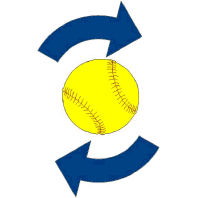|
by Gerald Warner, Softball Pitching
Instructor

Although it is not a “go to” pitch,
the screwball is an
excellent
weapon for a softball pitcher to have in
her repertoire of
pitches.
The screw ball hooks in the
opposite direction of a pitcher’s curve ball, which means for a
right handed pitcher, it curves to the right
(obviously, for a lefty a screw curves to the left).
Typically, the screw is thrown to a same-sided batter
up and on the inside corner…tight against the batter’s
hands. On occasion,
depending on the situation and the batter, it is thrown down and
in. For an
opposite-side batter (a right-handed pitcher throwing to a
left-handed batter, or a lefty throwing to a right-handed batter),
the screw ball can be used as a “chase” pitch…low and
away.
The keys to throwing a good screwball are
the same as for other breaking
pitches:
1.
It must
spin the correct direction
2.
It must
spin rapidly 
3.
It must be
thrown with sufficient
speed
The typical direction of spin for a
screwball is side-to-side (for a right hander
that means that the spin will be moving over-the-top to the
right, or for a left hander to the
left). This is an example of the direction
of the spin as seen by a right-handed pitcher as the ball heads
toward the plate:
Basic
mechanics for throwing a screwball:
GRIP:
As with most breaking pitches, the grip on the ball
can vary from one pitcher to another. However, many like to
place the pads of the fingers on the stitches at the top, or end, of
the “horseshoe” (or “U”).
Another option is for the 2nd and 3rd
fingers to be placed on the “narrows”…where the stitches come
closest together.
STRIDE:
Many pitchers are more effective by using a “side step” when
throwing a screwball, meaning that a right hander will step
well to the left of the power line. The length of the stride
should be essentially the same as for a
fastball.
"ARC" ARM SWING: We strongly recommend that
our pitchers use an “arc” motion instead of following a straight
line with the final portion of their arm
swing:
a)
As the arm
starts its final downswing toward the release, it is away from the
body
b)
Nearing
the release it closes in to the body…think of it is the inside of
the forearm brushing against your
abdomen.
c)
Then the
arm continues back out with the “arc” motion at the release of the
ball.
TIGHT SNAP AT THE
RELEASE:
The key to imparting a fast spin
on the ball is to twist it quickly as it is being released. The twist is
inside-out, meaning that a right hander twists the ball as shown in
the diagram
above.
As mentioned
previously, the screwball is usually not a “go to”
pitch. Typically, it is
thrown 10% to 15% of the time, depending on the situation, batter’s
aggressiveness and proximity to the plate, pitcher’s ability, and
the objective with this batter.
This article above
can be downloaded and printed from Microsoft Word

Do you want to reprint
this article or use it on your website or in your
newsletter?
As long as it is not for profit,
our only requirement is that you first notify us, then include the
following sentence:
Article by Gerald
Warner of PitchSoftball.com
and include a reference to
this website: www.pitchsoftball.com
If
you have questions or need more information
E-mail us, or call Pitching Instructor Gerald Warner in
Colorado at (720) 200-4575
| 











